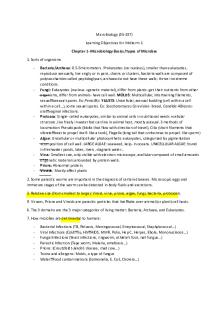Haematological Diseases by blood film (with images) PDF

| Title | Haematological Diseases by blood film (with images) |
|---|---|
| Course | Haematology 1 |
| Institution | University of Technology Sydney |
| Pages | 7 |
| File Size | 642.1 KB |
| File Type | |
| Total Downloads | 230 |
| Total Views | 494 |
Summary
Haematological DiseasesImage Name Cell MorphologyIndices DiseaseMicrocyte Small <6um RBCMCV <80fL Iron deficiency Anaemia ThalassaemiaMacrocyte Large >9um RBCMCV >100fL Folate deficiency B12 deficiency Liver disease AlcoholismHypochromic Pale cells MCH <27pg/cellAnaemia ThalassaemiaHy...
Description
Haematological Diseases Image
Name Microcyte
Cell Morphology Small 100fL
Folate deficiency B12 deficiency Liver disease Alcoholism
Hypochromic
Pale cells
MCH 32pg/cell
Anaemia
Poikilocytosis
Variation in shape Long and thin
Elliptocytes
Iron deficiency Thalassaemia
Spherocytes
Round and dense, no central pallor
Autoimmune haemolytic anaemia Burns Hereditary spherocytosis
Target cell
Target appearance
Schistocyte
Pointy edges, wedge, pizza shaped. Helmet cell, fragmented cell, trauma in circulation
Oval macrocyte
Fat juicy elliptocytes, seen in conjunction with hypersegmented neutrophils
High MCV
B12 and folate deficiency
Round macrocyte
Large round cell with some central pallor, seen with target cells in liver disease, can be a sign of dysplasia, can be seen with some drugs and medication
High MCV
Liver disease, hepatitis, alcoholism, obstructive jaundice
Liver disease: increased MCV Thalassaemia , Fe Def: decreased MCV
Liver disease, thalassaemia, Fe def
Haemolytic anaemia
Tear drop cell
Tear shaped
Thalassaemia
Burr cell
Dehydration Uraemia
Acanthocyte / spur cell
Looks like spherocyte with pointy projections
End stage liver disease Seen post splenectomy
Bite/Blister cell
Looks like a bite
G6PD deficiency Oxidative haemolysis
Sickle cell
Dense cells, no pallor, pointy ends
Abnormal Hb
Sickle cell anaemia
Rouleaux
Stacked cells
Increased CRP and ESR
Inflammatory disorders (caused by excess paraprotein) Multiple myeloma
Howell-Jolly bodies
Nuclear / chromosomal remnants
Seen post splenectomy Premature infancy Megaloblastic anaemia
Pappenheime r bodies
Iron particles, seen easily with an iron stain
Lead poisoning, sickle cell
Basophilic stippling
Altered Hb synthesis
Lead poisoning, alcoholism, megaloblastic anaemia
Heinz bodies
Appears as bite cells in normal film. Need a supravital stain to see (e.g., methyl violet, cresyl blue)
Unstable Hb Thalassaemia Haemolytic anaemia G6PD deficiency
Leucocytosis
Increase in number of WBC’s
Neutrophilia Lymphocytosis Eosinophilia Basophilia Monocytosis Infectious mononucleosis
Increase in number of circulating neutrophils. Left shift, toxic granulation, toxic vacuolation, Dohle bodies Increased numbers of eosinophils
>7 x 109/L neutrophils
Monocytosis
Increased number of monocytes
>0.8 x 109/L monocytes
Basophilia
Increase in basophils
>0.1 x 109/L basophils
Lymphocytosi s
Increase in lymphocytes
Toxic granulation
Large, blueblack granules in neutrophils
Neutrophilia
Eosinophilia
>0.4 x 109/L eopsinophils
Causes: bacterial infections, acute inflammations (burns), metabolic disorders, neoplasms, acute haemorrhage or haemolysis, drugs, rare inherited disorders Parasitic disorders Allergic conditions Asthma Adrenal disorders Skin conditions Autoimmune disorders Tumours Chronic bacterial infections, connective tissue diseases, protozoan infections, chronic neutropenia, Hodgkin’s disease Myeloproliferative disorder, chicken pox Acute infections (mononucleosis, rubella, pertussis), chronic infections (tuberculosis, toxoplasmosis), lymphocytic leukaemia Acute bacterial infections, burns, malignancies
Dohle bodies
Pale blue cytoplasmic inclusions in neutrophils
Inflammation, metabolic disturbances, severe infections, burns, toxicity, pregnancy, inherited abnormalities
Toxic vacuolation
Toxic granulation found in granulocytes (particularly neutrophils)
Bacterial infection
Pelger Huet anomaly
Incomplete lobation in neutrophils
May Hegglin anomaly
Blood platelet disorder, giant platelets, basophilic inclusions (RNA)
Autosomal dominant rare congenital blood platelet disorder
ChediakHigashi syndrome
Mutation of lysosomal trafficking regulator protein. Giant granules of cytoplasm in neutrophils and lymphocytes
Rare autosomal recessive disorder
Alder Reilly
Coarse granulation seen in neutrophils, eosinophils, basophils and monocytes
Kawasaki disease
Swelling of neutrophils, moderate rouleaux, toxic granulation
Whooping cough
Clefted nucleus, elevated WBC, lymphocytosi s
Rare autosomal recessive disorder
Elevated ESR, CRP, alpha 1 antitrypsin, high WBC count, left shift
Kawasaki disease
Whooping cough...
Similar Free PDFs

Apgar poster with images
- 1 Pages

Blood into Wine Film Notes
- 5 Pages

Haematological History
- 2 Pages

Vulval diseases
- 1 Pages

Health and Diseases Vocabulary
- 6 Pages

Blood Bank case study with solution
- 16 Pages

Blood
- 30 Pages

16. Immunoproliferative Diseases
- 1 Pages
Popular Institutions
- Tinajero National High School - Annex
- Politeknik Caltex Riau
- Yokohama City University
- SGT University
- University of Al-Qadisiyah
- Divine Word College of Vigan
- Techniek College Rotterdam
- Universidade de Santiago
- Universiti Teknologi MARA Cawangan Johor Kampus Pasir Gudang
- Poltekkes Kemenkes Yogyakarta
- Baguio City National High School
- Colegio san marcos
- preparatoria uno
- Centro de Bachillerato Tecnológico Industrial y de Servicios No. 107
- Dalian Maritime University
- Quang Trung Secondary School
- Colegio Tecnológico en Informática
- Corporación Regional de Educación Superior
- Grupo CEDVA
- Dar Al Uloom University
- Centro de Estudios Preuniversitarios de la Universidad Nacional de Ingeniería
- 上智大学
- Aakash International School, Nuna Majara
- San Felipe Neri Catholic School
- Kang Chiao International School - New Taipei City
- Misamis Occidental National High School
- Institución Educativa Escuela Normal Juan Ladrilleros
- Kolehiyo ng Pantukan
- Batanes State College
- Instituto Continental
- Sekolah Menengah Kejuruan Kesehatan Kaltara (Tarakan)
- Colegio de La Inmaculada Concepcion - Cebu







